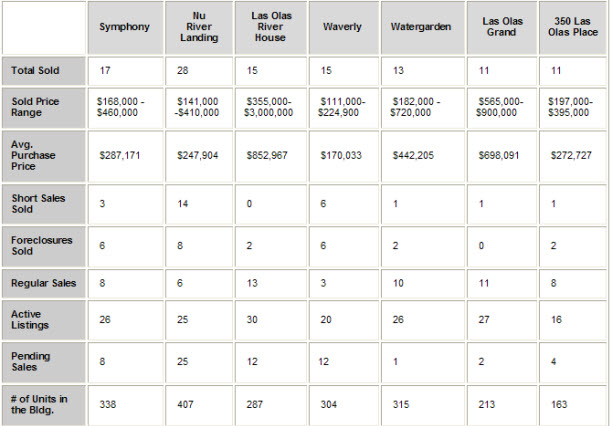Las Olas area Condos remain in high demand and I frequently work with them. I gathered data about the Sales for the first 6 months of 2010 (January 1, 2010 - June 30, 2010) in Las Olas River House, Symphony, Nu River Landing, Waverly, Watergarden, Las Olas Grand, and 350 Las Olas Place and included it in the Table below.

The numbers clearly show that Market conditions vary significantly in various Buildings and I included some important notes below.
- On average, around 10% of the Units in these Buildings are listed for sale and 10% IS NOT considered to be excessive. When reviewing information about the number of active listings in a Building, you must consider the total number of Units in the Building as well. I often hear things like: "Why are there so many listings in the Building?" or "I heard we shouldn't buy in Building X because everything is for Sale" when, in reality, the number of active listings is small in comparison to the total number of listings in the Building
-
Of 110 Units purchased in the 7 Buildings, 83 are indicated to have been Cash purchases, as is typical in the current market.
- There's a widespread misconception that if a Unit isn't a Short Sale, then the Owner is trying to sell it for what they paid for it and that it's not a good deal. When a property is listed as a Short Sale, it means that the Owner wants the Lender who Financed their purchase of the property to take a loss on the Loan and let a new Buyer purchase the property for today's market value or slightly less, instead of the higher price that was paid several years ago. Properties that are listed as Short Sales require Bank approval of the purchase terms and price. View additional information about Short Sales here.
Just because a property wasn't sold as a Short Sale doesn't mean that the Owner didn't take a loss and sell it for less than what they paid for it. The vast majority of properties that were purchased during peak market prices are sold for less than their previous purchase prices and are sold for today's market values or slightly below. The difference is that there are Sellers who are financially capable of personally taking the loss instead of asking their Lender to do so (that means they are personally paying the Lender for the shortage at the time of Closing because they don't want to ruin their Credit by doing a Short Sale) OR they paid Cash for the property and there isn't a Loan at all OR there's a Loan on the property, but the down payment was large. This is typical in higher purchase price ranges and Buildings and Communities where many high net worth individuals reside. - With all properties, when comparing previous purchase prices to current purchase prices, you need to consider the Property's condition at the time of previous purchase to its' current condition. I'm referring to cases where properties have been significantly changed and/or improved since the time of purchase. An example of this is Sellers in today's market who purchased Decorator ready Units during the peak of the market (Decorator Ready Units are unfinished Units that require installation of Flooring, Light Fixtures, Molding, etc.) Such was the case in Las Olas River House and a number of other Buildings. So, let's say that Mr. and Mrs. Smith purchased Unit 1234 in Las Olas River House for $500,000 and then spent $300,000 for various finishing and customization of the Unit. Their cost for the Unit is now at $800,000 instead of the $500,000 purchase price, so if they're selling today for $600,000, they're losing $200,000. I've had Buyers say to me: "I looked at Property Tax Records and Mr. and Mrs. Smith paid $500,000 in 2005, now they're trying to rip us off by selling for $100,000 more than they paid" (they felt that way because they were mis-informed and didn't understand that they weren't comparing "Apples to Apples".)
This issue also potentially decreases the number of Short Sales in the Building because if Mr. and Mrs. Smith obtained a Mortgage for $400,000 to purchase their $500,000 Condo, they can sell at today's market prices without the necessity of doing a Short Sale through their Lender even though they're selling at a Loss (since the money paid to finish the Unit was from their personal Funds and not related to the Mortgage).
All sides of an issue must be considered in order to gain accurate understanding. - Additional issues that impact the number of Short Sales and Foreclosures in a Building include, but aren't limited to:
>The number of Investors who purchased
>The financial health of the Owners
>The number of Financed purchases and Adjustable Rate Mortgages
>Purchase dates and purchase prices for the majority of the Owners
Related Information:
- 2010 Broward County Luxury Condo Sales
- Cash Buyers of South Florida Real Estate
- 5-Year Broward County Real Estate Market Snapshot
- Broward Foreclosure Market Report
- Ft. Lauderdale Waterfront Condos
- Las Olas Condos
- Nu River Landing Condo
- Symphony Condo
- Las Olas River House Condo
- Waverly Condo
- Watergarden Condo
- Las Olas Grand Condo
- 350 Las Olas Place Condo
- Ft. Lauderdale Decorator Ready Condos
- Ft. Lauderdale Foreclosures
- Ft. Lauderdale Short Sales
--------------
Vickie Arcuri, Realtor®
EWM Realtors, Inc.
1700 E. Las Olas Blvd.
Ft. Lauderdale, FL 33301
Phone: (954) 708-9309
Fax: (954) 414-0492
Vickie@vickierealestate.com
Ft. Lauderdale Homes for Sale
Ft. Lauderdale Waterfront Homes
South Florida Real Estate Blog


Comments(0)